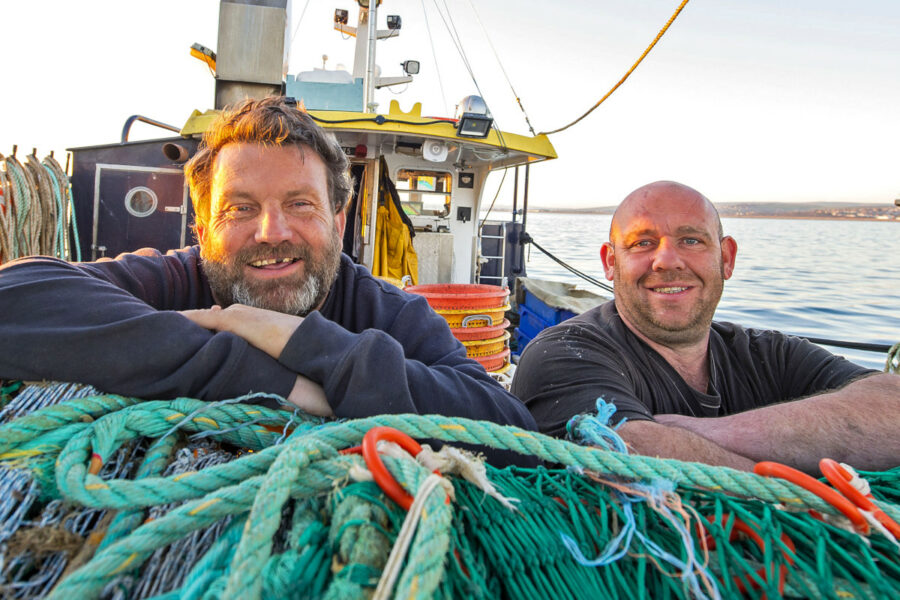Newhaven skipper Neil Witney and crewman Darren ‘Daz’ Fox welcomed Fishing News aboard the under-12m trawler About Time NN 8, to view a day’s fishing in the English Channel.
John Periam and Geoffrey Lee report
Neil Witney has been fishing from Newhaven in East Sussex on and off since 1986. In the early days, there used to be 80 boats fishing from the port. Currently, there are 25 moored at the quay, and 10 inside the small marina.
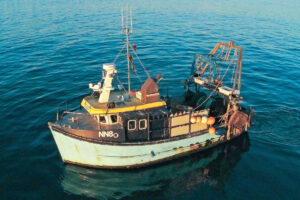
The Newhaven inshore trawler About Time.
Neil is a close friend of Mudeford fisherman Peter Dadds (Fishing News, 25 October, 2018), and it was due to reading that feature that he invited us to spend a day at sea with him.
Neil’s boat is the 11.99m wooden-hulled trawler About Time NN 8, which was launched in 1988 by Greensleeves Boatbuilders in Lytchett Bay boatyard, Poole, Dorset, as Tudor Rose PE 8.
On moving down the coast, Tudor Rose was renamed About Time PE 8. The vessel’s registration changed to GK 8 when About Time was sold to Girvan, later becoming HH 8 when sold on to Essex.
When skipper Neil Witney bought About Time two years ago, its registration changed for a fourth time, with the number 8 being retained.
“I like wooden-hulled boats, so it was ideal for me,” said Neil. “Its registered tonnage is 16.4t, and it is powered by a Gardner 8LXB of 127kW @ 1,200rpm, with a cruising speed of 7-8 knots.
“Deck machinery includes a Spencer Carter two-barrel 2.5t trawl winch and 3t net drum. A Hiab Type 90 deck crane is fitted aft to assist with handling the trawl, as well as landing. The hydraulics are driven off the fore end of the Gardner main engine.
“The accommodation cabin forward has three bunks, together with the usual bench seating, table, and washing and cooking facilities.
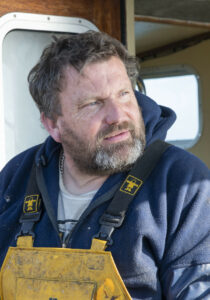
Skipper Neil Witney.
“Communications, navigation and fishing wheelhouse electronic equipment includes Sailor RT2048 and Simrad RD68 DSC VHFs, a handheld HYT TC-700 VHF, Comnav AIS, Simrad DS34 chart plotter, JRC JLR-21 GPS compass, Furuno GP32 navigator, Simrad CX44 chart navigator, Hondex HE-7300V sounder, MaxSea TimeZero 2D and 3D plotting system, and Simrad AP35 autopilot.”
Currently, skipper Neil Witney fishes About Time with crew member Darren ‘Daz’ Fox, who joined him in January this year. “I know Darren and his family well; he has strong fishing connections, which helps a lot. It is nice to have someone onboard I can share a good working relationship with,” said Neil.
The day proved to be a normal day’s fishing for Neil and Daz. They left Newhaven at 5am, and headed out nine miles to target squid, lemons and whiting in the deep water south of Beachy Head.
Fishing in 30 fathoms of water, About Time towed a 42ft fine-wing rockhopper trawl rigged on 8- to 10in-diameter discs. A set of Bison No. 5 trawl doors, together with 30 fathoms of bridles, are used to spread the net. From the back of the trawl doors, the bridles are made up of eight fathoms of 18mm combination warp, a short (two-fathom) length of chain, 20 fathoms of 14mm wire, and eight fathoms of splits. Ninety fathoms of 12mm-diameter trawl wire are usually shot, to give a typical door spread of 160ft. The bridles are hauled on top of the wires on the trawl winch.
When About Time arrived at the designated waypoint on the plotter, skipper and crewman slipped into their well-established routine, with the trawl being shot off the drum before the doors, and the wires run off the winch barrels, before the brakes were applied. When the gear was square, About Time followed an easterly heading across the ground at a steady 1.5 knots, with the Gardner engine running comfortably at 1,125rpm.
After four hours, the hydraulics were clutched as Neil and Daz prepared to haul. With the wing ends hanging from the trawl gallows, Neil took a few turns of the dogrope around the port whipping drum of the winch, to haul the codend to the port quarter, before it was taken aboard, and the catch released.
Satisfied with a mixed catch of whiting, squid and lemon sole that they described as ‘fairly average’, and that there were no problems with the net, the trawl was quickly shot away again for the second, and what would probably be the last, shot of the day.
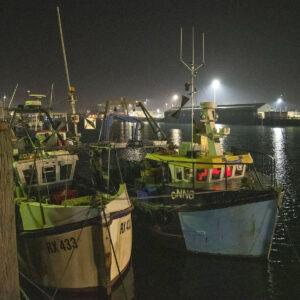
Ready to throw the ropes off – About Time moored outside Neil Witney’s previous boat Emma Louise RX 433 on Newhaven’s West Quay.
Crewman Darren Fox said: “About Time was well-built, and the working arrangements are carefully thought-out and well-suited to our requirements. As a result, hauling the trawl, taking fish aboard, and selecting, gutting, washing and boxing the catch is a very methodical process. Working on the deck area, one feels safe, and the safety rails help a lot if the weather changes quickly. Neil is very safety-conscious; we have all the required safety gear onboard, and he checks it on a regular basis. Cleaning the decks and storage is also important, minimising any risk of slipping or falling. It is a real delight to work with Neil.”
The new Maritime and Coastguard Agency (MCA) regulations regarding the wearing of PFDs may not appeal to all fishermen, and there have been some concerns aired. Neil feels it is important, when at sea, to wear them in certain situations. “You only have to look at Peter Dadds’ incident off Mudeford to realise just how lucky both onboard his 6.9m Cheetah Déjà Vu were to survive after its capsize. It was their knowledge about safety at sea, having the right gear onboard, and build quality and proper vessel maintenance that helped. Going to sea on a safe boat is top of my list. It is important to me that I can return home, along with Daz, after a day’s fishing, to see my wife Emma and my six children.”
On an unseasonably fine morning in early March, other vessels were fishing near About Time, including another six Newhaven boats and a bigger Belgian beamer.
While monitoring the AIS track of that vessel, Artevelde B 65, skipper Neil Witney said, “The bigger boats are getting more common. The other day, we had close encounters with French, Belgian and Dutch boats. Some of these are former beamers converted for fly-shooting. If they were still beam trawling, with their horsepower they would be working outside the 12-mile limit. By changing to fly-shooters, they are now allowed into our six-mile limit according to EU regulations, which I personally think is wrong.”
When asked why, Neil replied, “Most of the inshore fleet in this area have a maximum length of 14m – otherwise you’re outside six miles anyway. The smallest size of one of the foreign boats is around 24m. Earlier this year, a boat of LOA 40m with 3,500hp was fishing nearby, with its AIS turned off.
“Only last week, I reported one, as the coastguard clearly states that any commercial vessel of 15m should have its AIS on, in order to display its position and track at all times. When they are coming at you, and you don’t know who or where they are, it can cause concerns.
“For example, fly-shooters can have up to four miles of gear astern of them, as they shoot in a diamond pattern, which can be very worrying. They work very close to their designated limits, and often cross them. We often refer to ‘zero 6.001’, which clearly is as close as they can get – when staying within the rules.”
Daz said, “The other day, there must have been 25 Boulogne trawlers fishing in a pack 11 miles south of Newhaven, and the AIS was covered with brown dots. They were there because they knew there was an abundance of squid in the area. It is at times like this that their movements need to be monitored. I will be glad when we can see more of the Royal Navy fishery squadron vessels around. I know there are issues with both replacement ships and with migrants, but there is no doubt that having them in view, at times, acts as an excellent deterrent.”

Daz tying the codline in preparation for…
Inevitably, the conversation turned to what UK inshore fishermen, trying to eke out a living on meagre quotas, have to do to comply with current regulations. Only a few days before this trip, Neil and Daz returned to Newhaven having had to throw back 1.5t of bass, after taking a surprise and unwanted by-catch they had no control over. Even when the bass ban ends later this month, they will only be allowed to land a 1% by-catch.
Skipper Neil Witney said, “That was about £6,000 to £8,000 of fish that went back over the rail, which immediately raises the question: are foreign boats doing the same, and if not, why not?”
For Geoff Lee, who was onboard taking pictures for this feature, it was another learning curve. “To hear such stories relating to dumping fish back in the sea was very upsetting,” he said. “I could see it in Neil’s face when he was explaining the situation to me.
“Every aspect that they do in a day’s work was so well-organised. Together, Neil and Daz make an excellent team, and they work so hard to make a living.
“They have families to support, and are at sea for long hours, as I found out. Today, it was for just over 10 hours, but more often, it is 15 to 18 hours. Wind farm development, cable areas, MCZ zones and proposed new seaweed farms are sending them ever-further out to sea. They use more fuel, and are involved in a lot more administration work when they return to Newhaven. It is not an easy life, and that is without taking quotas and inclement weather into account, on a daily basis. Every day on shore is more lost income.”
At Newhaven, in common with many other ports that, just a generation ago, were home to sizeable fleets, there is little, if any, evidence of youngsters coming into the industry.
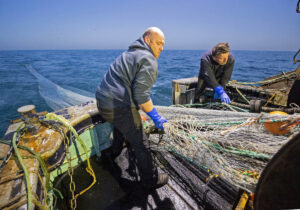
… shooting the trawl off the net drum…
Neil commented, “I have two 17-year-old sons, and neither wants to go to sea or follow in my footsteps. It was so different when I was young – I have tried to encourage them, but to no avail, and there is no incentive.”
Returning home to Newhaven at a steady seven knots, after the second haul of the day, gave skipper Neil Witney an opportunity to share more of his concerns.
“There is no doubt, when it comes to Brexit, that the larger vessels should be outside the 12-mile limit. There are some places where three beamers a week are working, and they are taking, on average, between £25,000 and £30,000 of fish, mostly made up of soles, plaice and lemons. What is happening is that fish are not being allowed to breed there, so they are not coming into our shores. We know that if the beamers have been very active in an area, we will get nothing for at least six weeks afterwards.
“There is a lot of squid at the moment, which like clear water, and that is what is attracting the EU vessels.”
Neil also expressed concern about issues relating to wind farms and power cables, citing the mounting evidence that they are having a negative impact on the fishing industry, as Paul Gilson of Leigh-on-Sea highlighted in Fishing News (28 February, ‘Human interference – are wind farms environmentally friendly?’).
“I have a great deal of respect for Paul, and he works very hard. He is one of a special breed of fishermen, who gives a lot of his time to the industry.”
In the area that Neil Witney fishes south of Newhaven, there is currently a closed area of eight by six miles, due to wind farm development work. There is also the cable route running from the shore out to the new site, which is 0.5 miles wide and 6.5 miles long, resulting in a lot of rock movement on the seabed.
Further ground could be lost as a result of the proposed development of five seaweed farms, each of which would be the size of more than five football pitches.

Plotting the course of the Belgian beamer…
“They put an anchor down on each corner of the site, and then there are ropes running about 3m down on which weeds grow, similar to mussel farms. When the seaweed is ready, it is hauled to the surface,” explained Neil.
“This development is in the final approval stage, and could well be another hazard for us to look out for, linked to further loss of fishing grounds. From what I gather, some will be in close proximity to marinas, and in other more accessible areas. Little publicity has been given to these, other than a small mention in the local press, and on some yacht club noticeboards. I wonder why?
“The Sussex Inshore Fisheries and Conservation Authority (IFCA) ruling on not working from a quarter- to a half-mile off the beach is also causing us some worries. If you haven’t got AIS, before you know it, you could be outside the mile. We need to be able to sit around a table and discuss things more, rather than be told of changes when it is too late.
“It now costs a lot more to do a day’s fishing. Paperwork has increased, which at times results in more worries, in case one has forgotten to fill one of many columns by a specific date – not because you are doing wrong, but because it is so easy to make a small mistake, and before you know it, issues can develop and fines be incurred. At the end of the day, it is all about keeping abreast of the many changes in regulations made by others behind the scenes.
“We need sustainable fishing where common sense prevails. We need more opportunities to communicate – there are barriers put up, when doors should be opened. Every time we go to sea, there are other hurdles to overcome. For example, why is it that fishermen know more about the proposed seaweed farms than others, who should do?
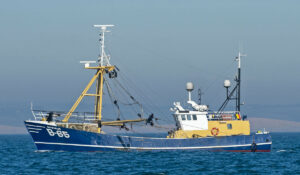
… Artevelde B 65, towing near About Time.
“At Newhaven, things have changed, and like in many fishing communities, the opportunities to meet the public have all but gone. Any new developments we want to make around our moorings can cause some issues. Newhaven is a port, and facilities to fit into that description can be of concern to some local residents. New property developments around fishing communities often bring in people who expect fishermen to fit their working day to their requirements. That cannot be the case, and they must understand that fishermen do need to go to sea early in the mornings. Similarly, returning to port after a day’s fishing is linked to tides, and the harbour entrance at Newhaven can be a little challenging at times.”
The boxed catch from About Time’s trip included gurnard, whiting, pout whiting, squid, plaice, flounder, brill, lemon sole, red mullet, pollack and tope. After being lifted onto West Quay, the boxes were placed on a pallet, before being iced and placed in a modern refrigerated store. At midnight, the next team come in to weigh and record the catch before it is distributed. About Time’s catch goes through Southern Head Fishing Company at Eastbourne, as well as to Belgium.
There is no doubt that Neil and Daz enjoy what they do. They wake up wanting to go to sea, even though the hours can be long, and catches can vary. As in most fishing communities, the wives behind the scenes are very supportive.
Neil added, “Things will improve if we can get that all-important six-mile limit up and running, move away from quotas, and work together a lot more to solve the industry’s problems. As I mentioned earlier, my two sons do not want to follow in my footsteps. I do find that a little worrying. We really need to encourage youngsters into fishing. If they can see a safer, sustainable and supportive industry taking away some of the financial hardships involved, I am sure some will look favourably at learning new skills.
“It was our pleasure to have Geoff Lee onboard today, and I look forward to seeing his photos. He came highly recommended by Peter Dadds. By running these features, Fishing News gives an insight into how many of us working in the inshore sector try to make a living. It would be nice if the national press realised the same, and supported us just that little bit more.”

